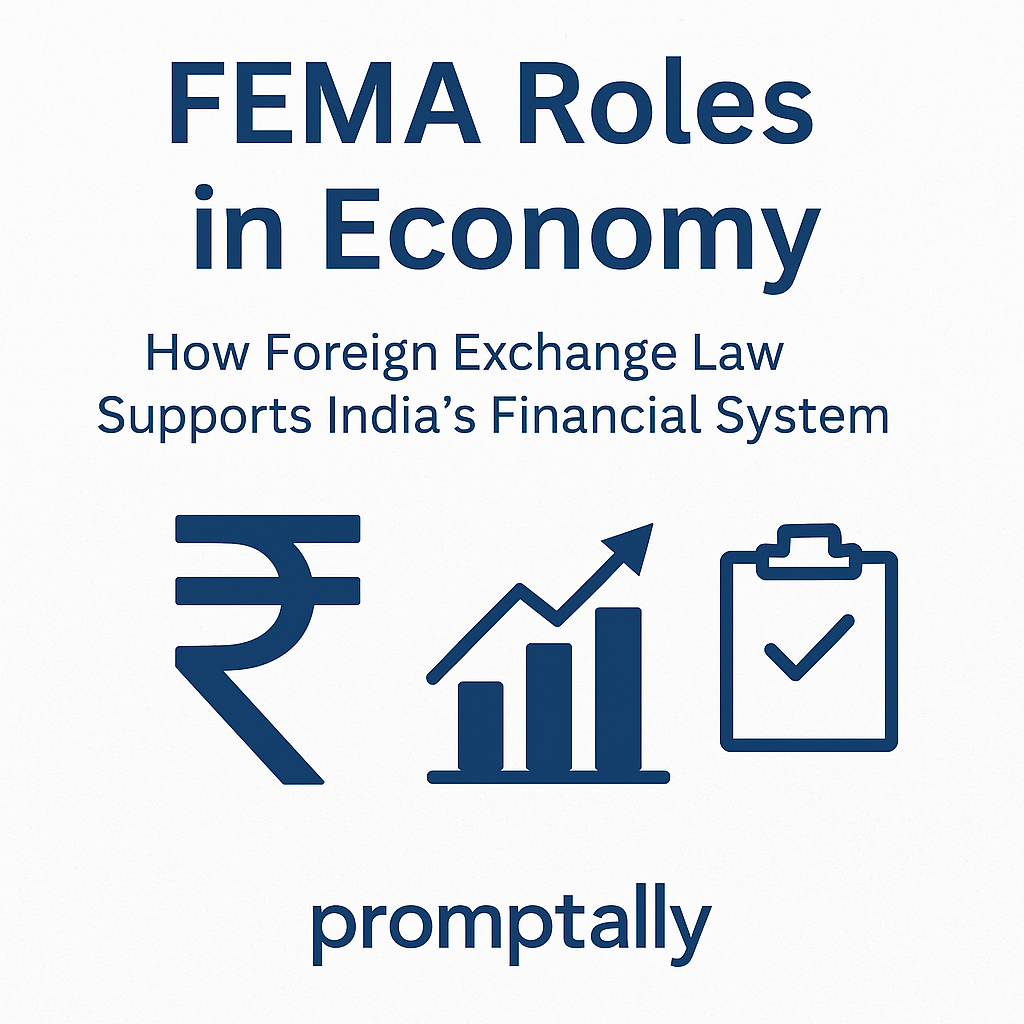This article is about the understanding FEMA: Roles in the Indian Economy. In a globalized world, foreign exchange transactions are crucial for a country’s economic development. Whether it’s a business investing in India, an NRI remitting funds, or an Indian company exporting goods — all of these activities involve foreign exchange. To regulate and streamline these transactions, India relies on FEMA – the Foreign Exchange Management Act, 1999.
Let’s explore more on FEMA and why it was introduced, and how it plays a vital role in shaping India’s financial stability and economic growth.
What is FEMA?
FEMA stands for Foreign Exchange Management Act, enacted in 1999, replacing the earlier Foreign Exchange Regulation Act (FERA) of 1973. While FERA was more restrictive and criminal in nature, FEMA adopted a more liberal and facilitative approach.
The primary objective of FEMA is:
“To facilitate external trade and payments and to promote the orderly development and maintenance of the foreign exchange market in India.”
FEMA empowers the Reserve Bank of India (RBI) and the Central Government to regulate foreign exchange transactions — both current account and capital account — in line with the country’s macroeconomic priorities.
Why Was FEMA Introduced?
India faced a severe balance of payments crisis in the early 1990s. This led to economic liberalization and the need to shift from control to management in foreign exchange dealings.
FERA was seen as outdated and overly punitive. FEMA, in contrast, was designed to:
- Promote foreign trade and investment
- Simplify procedures
- Align with WTO norms
- Ensure compliance without being overly harsh
Key Features of FEMA
- Civil, not criminal: Violations are treated as civil offenses.
- Applies to all: Indian citizens, NRIs, foreign companies operating in India.
- Covers a broad scope: Current account transactions, capital account transactions, foreign investments, repatriation of funds, etc.
- Involves RBI oversight: Most forex-related permissions and regulations come under the RBI’s purview.
Roles of FEMA in the Indian Economy
FEMA plays multiple critical roles that help India maintain its economic sovereignty, currency stability, and global financial reputation.
1. Regulating Foreign Exchange Transactions
FEMA sets the legal framework to manage the inflow and outflow of foreign currency, ensuring India’s foreign exchange reserves are used wisely and efficiently. It ensures that:
- Money coming into or going out of the country is legitimate.
- Unauthorized dealings are penalized.
- RBI has the authority to monitor foreign exchange markets.
2. Supporting External Trade and Payments
FEMA facilitates smooth international trade by regulating payments related to exports, imports, and services. This ensures:
- Exporters receive their payments in foreign currency through legal channels.
- Importers adhere to forex guidelines when sending money abroad.
- India’s trade transactions remain transparent and traceable.
3. Attracting Foreign Investment (FDI & FPI)
To boost the Indian economy, FEMA enables foreign investors to invest in Indian businesses. It regulates:
- FDI (Foreign Direct Investment)
- FPI (Foreign Portfolio Investment)
- Repatriation of profits or dividends
These inflows improve capital formation, create jobs, and drive technological advancement.
4. Maintaining Balance of Payments (BoP)
By managing forex inflows and outflows, FEMA helps India maintain a healthy BoP position, which is critical for:
- Stabilizing the Rupee
- Managing inflation
- Maintaining investor confidence
It plays a silent but strong role in making India’s macroeconomic indicators stable.
5. Monitoring NRI Transactions
NRIs contribute significantly to India’s foreign reserves. FEMA governs:
- NRI investments in real estate and businesses
- Repatriation of funds from NRO/NRE accounts
- Inheritance and gifts involving foreign exchange
This ensures that overseas Indians stay compliant while staying connected to the Indian economy.
6. Controlling Capital Account Transactions
While India is cautious about full capital account convertibility, FEMA allows regulated capital movements such as:
- Loans and borrowings from abroad
- Transfer of Indian assets by residents or foreigners
- Investments outside India by Indian residents (under LRS – Liberalized Remittance Scheme)
This balances economic openness with financial stability.
7. Strengthening RBI’s Role
FEMA empowers the Reserve Bank of India to regulate and oversee:
- Exchange rate policies
- Forex reserves
- Financial institutions dealing in forex
- Reporting compliance by banks and businesses
This centralizes control in a trusted institution and ensures better management.
8. Encouraging Transparency and Compliance
With digitalization and real-time tracking, FEMA promotes transparency through:
- Regular reporting of foreign transactions
- Online documentation
- Penalties for evasion or non-compliance
This builds trust with global investors and trade partners.
FEMA vs. FERA – A Quick Look
| Aspect | FERA (Old) | FEMA (Current) |
|---|---|---|
| Nature | Criminal law | Civil law |
| Presumption | Guilty until proven innocent | Innocent until proven guilty |
| Approach | Restrictive | Liberalized |
| Penalty | Jail and fines | Mainly monetary penalties |
| Focus | Control | Management and facilitation |
Conclusion
FEMA might not be a daily topic in the news, but it’s a cornerstone of India’s economic architecture. It ensures that India engages with the global financial system in a secure, regulated, and transparent manner. From trade and investments to remittances and capital flows, FEMA’s invisible hand keeps India’s economic engine running smoothly.
For individuals, businesses, and investors — understanding FEMA means understanding how India balances freedom with financial responsibility.
